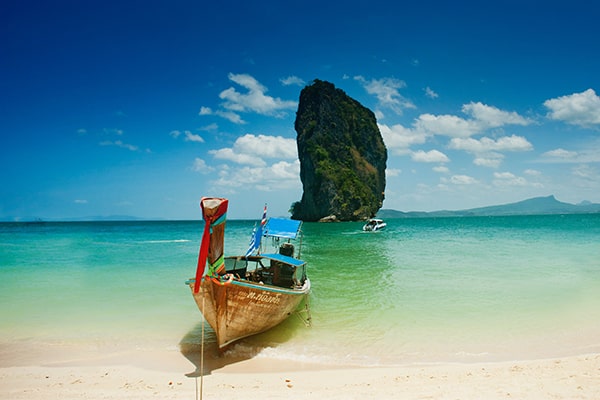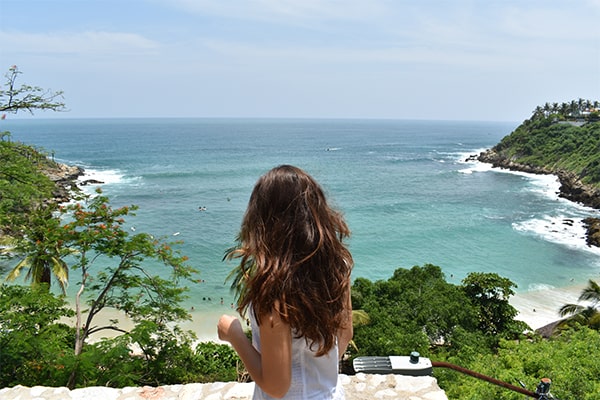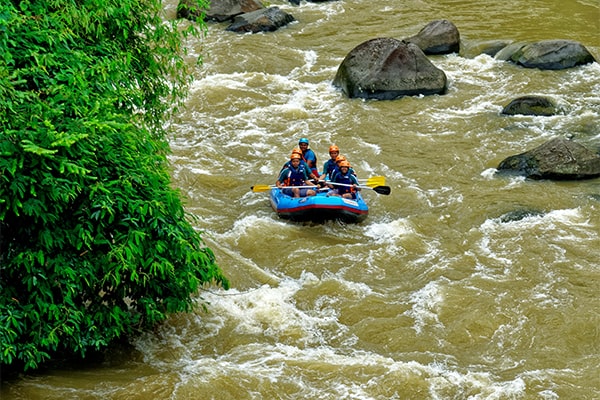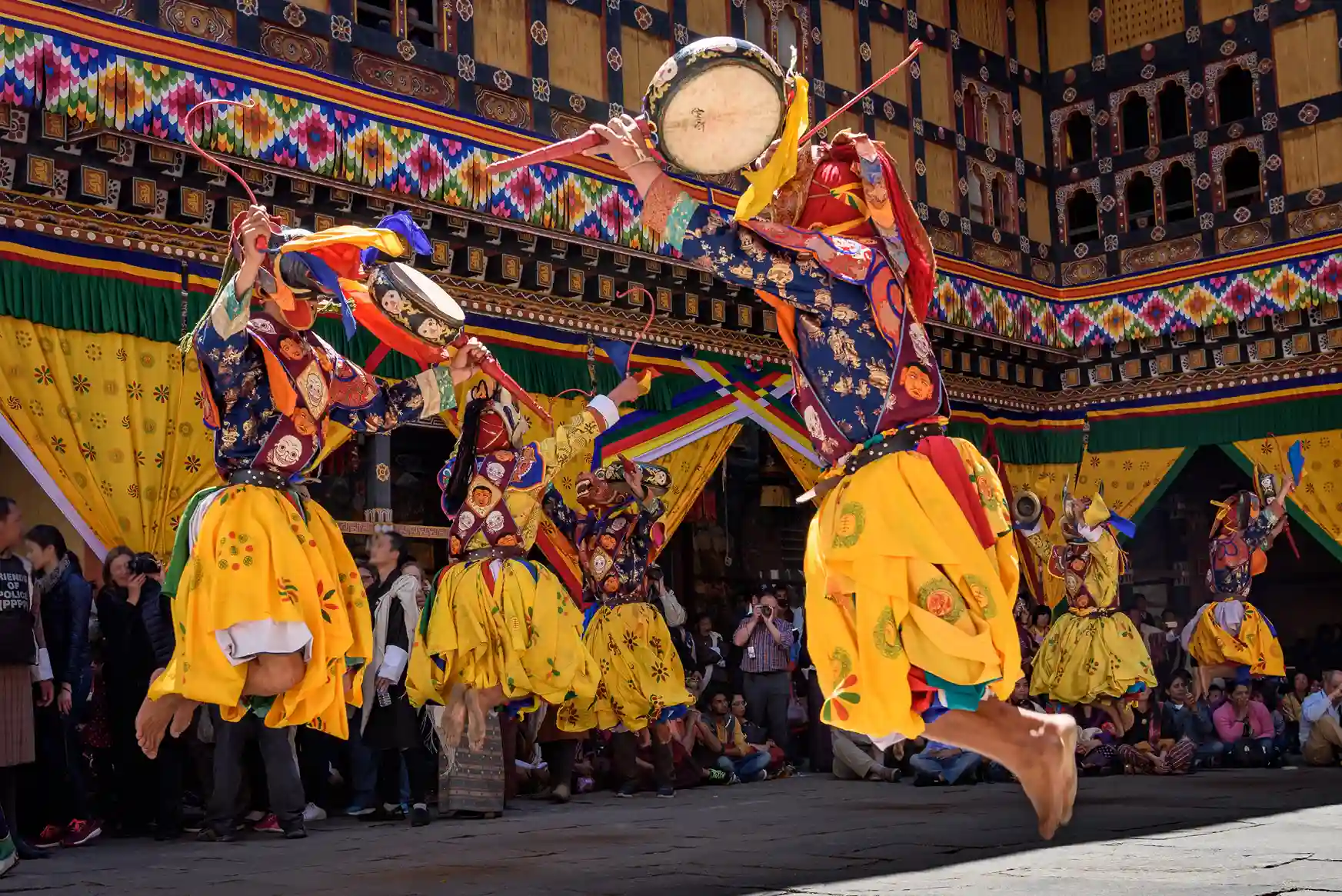
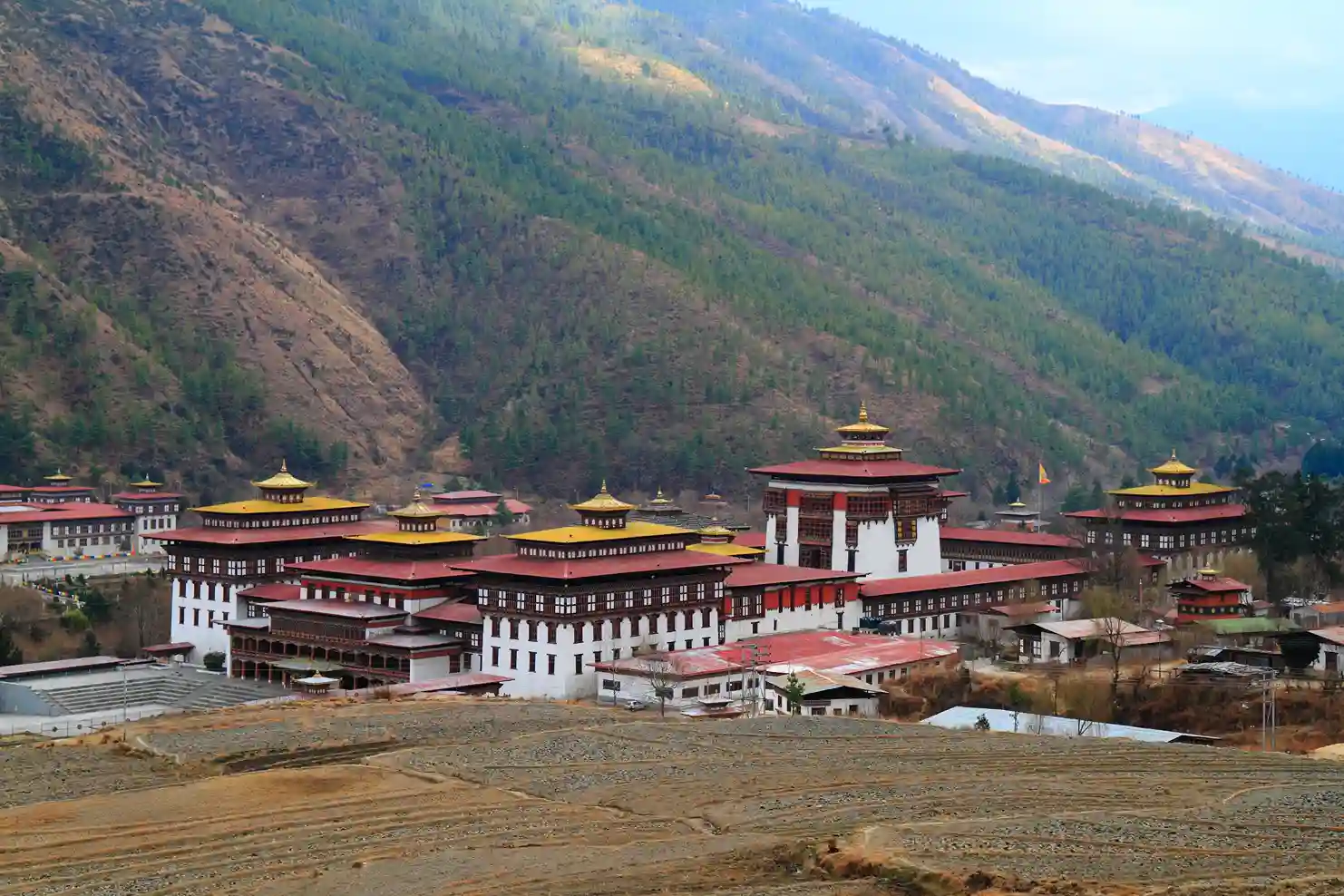
.webp)

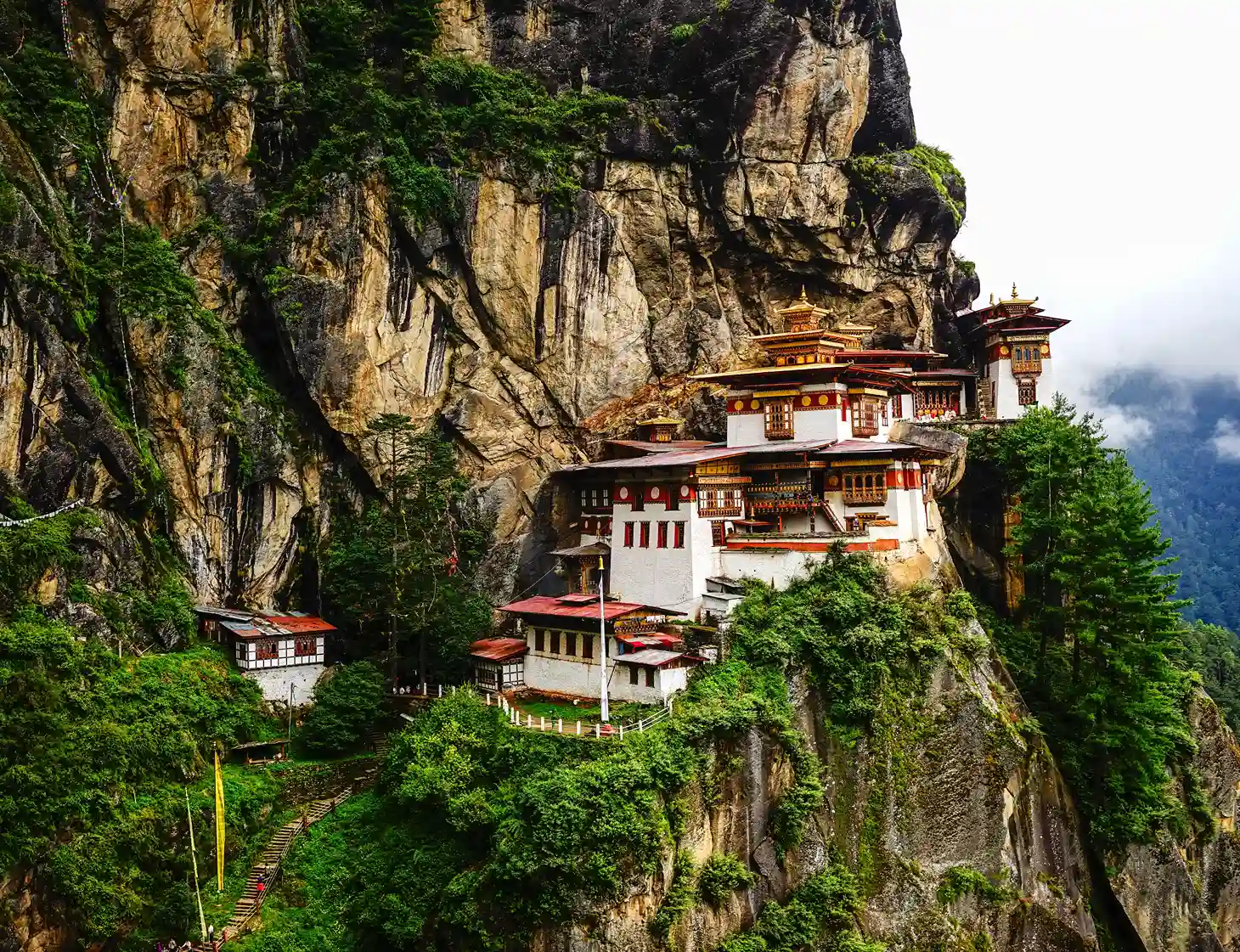
Adventure Bhutan
5N / 6D Transfer Hotels Sightseeing
Meals
Bhutan is rightly known to the world today as the Last Shangri-La. It was the mighty Himalayas that protected Bhutan from the rest of the world and left this Himalayan jewel blissfully untouched. The Drukpa Kagyupa sect of Mahayana Buddhism provided the essence of a rich culture and fascinating history. The Bhutanese people protected this sacred heritage and unique identity for centuries by choosing to remain in a jealously guarded isolation. This country of rolling hills and towering crags certainly exudes charm. The mountains are magnificent, the forests are dense, the people are delightful, the air is pure, the architecture inspiring, the religion exciting and the art superb. Like timeless images from the past, the traveller encounters the full glory of this ancient land through its strategic fortresses known as Dzongs, numerous ancient temples, monasteries and stupas which dot the countryside, prayer flags which flutter along the high ridges, wild animals which abound in dense forests, foamy white waterfalls which are the ethereal showers, and the warm smile of its friendly people. With its beautiful and largely unspoiled Himalayan setting, its rich flora and fauna and its vibrant Buddhist culture, Bhutan has become an increasingly popular destination for international tourists.
Day 1
Arrive Paro by Flight & transfer to Thimphu (55km/2-hour)
The flight to Paro is one of the most spectacular in entire Himalayas. Flying along the Himalayan range from Kathmandu or over Himalayan foothills if flying over Kolkatta, the journey offers fascinating views and an exciting descent into the Kingdom. Bhutan’s first gift to you as you disembark from the aircraft will be cool, clean fresh mountain air.After immigration formalities and baggage collection you will be welcomed by our representative with a ‘tashi khaddar’ (white scarf offering to the guest which is an auspicious way to welcome guest) and drive to Thimphu, the capital town of Bhutan. The road leads through the Paro valley to the confluence of Paro and Thimphu rivers at Chuzom (confluence).Shortly before reaching Chuzom, you will see on your left Tamchog Lhakhang, the temple built by Thangtong Gyalpo, a pioneering engineer who introduced the construction of suspension bridges into Bhutan and Tibet (several of which are still in use today). The present bridge to Tamchog Lhakhang was restored in 2005 in the design of a traditional style with iron chains and crossing this iron bridge is a wonderful experience. (approx. 50 min, roundtrip walk).On arrival, in Thimphu check-into the hotel. The capital town of Bhutan and the centre of government, religion and commerce, Thimphu is a unique city with unusual mixture of modern development alongside ancient traditions.Later in the evening visit Later in afternoon visit National Memorial Chorten, a large white structure crowned with a golden spire. It is located close to the center of Thimphu city and is one of its most iconic monuments. This is the most ideal spot to interact with locals who throng in large numbers to circumambulate the chorten, whirl the large red prayer wheels and pray at a small shrine inside the gate. The paintings and statues inside the monument provide a deep insight into Buddhist philosophy. Before returning to the hotel, take leisurely walk to local craft Bazar recently established under patronage of Department of cottage & small industry and in collaboration with the department of culture, tourism council and the department of agriculture marketing and cooperatives. This market offers genuine Bhutanese arts & crafts thus contributing to promotion, protection, and preservation of traditional arts.Overnight at the hotel in Thimphu. (Altitude 2320m)
Day 2
Thimphu Sightseeing
Morning after breakfast, take a short drive to the north of town to Buddha Dordenma, located atop a hill in Kuenselphodrang Nature Park. The statue fulfils an ancient prophecy dating back to the 8th century A.D that was discovered by Terton Pema Lingpa (Religious Treasure Discoverer) and is said to emanate an aura of peace and happiness to the entire world. This massive statue of Shakyamuni made of bronze and is gilded in gold, measures 51.5 meters in height, making it one of the largest statues, in Bhutan. 125,000 smaller Buddha statues have been placed within the Buddha Dordenma statue, each of these also have been cast in bronze and gilded. Here at Buddha point, you’ve option to perform meditation at a designated area. Followed by city tour visiting Textile Museum, the living national art of weaving. The place introduces the major weaving techniques, styles of local dress and textiles made by women and men & Folk Heritage Museum encapsulating the cultural heritage of the Bhutanese people. You can enjoy lunch at the Folk Heritage Musuem. Post lunch, visit Changangkha Lhakhang, one of the ancient temples located on a ridge above Thimphu. It was established on a site chosen by Lama Phajo Drugom Shigpo, who came from Tibet and regarded as the founder of Drukpa lineage in Bhutan. The temple was laid in 12th century while the work of which was extended by his son in the 13th century. The central statue here is Chenrezig in a manifestation with 11 heads. For centuries, parents come here for blessing of their new-borns from the protector deity Tamdrin and children are blessed by a phurba (ritual dagger) and given a sacred thread. From temple courtyard, there is fascinating view of Thimphu valley. Then drive to Takin Preserve to see Bhutan’s national animal Takin, located in the Motithang district of Thimphu. Originally a mini zoo, it is now converted into a reserve area for the Takin.It is an extremely rare bovid mammal of the ovine-caprine family. Takin has been diligently chosen as the National animal of Bhutan, because it is unique, rare, and native to Bhutan, closely associated with the religious history and mythology of the Country. Conclude the sightseeing of the day with visit to Trashichhoedzong, ‘fortress of the glorious religion’. This is the center of government and religion, site of monarch’s throne room and seat of Je Khenpo or Chief Abbot. Built in 1641 by the political and religious unifier of Bhutan, Zhabdrung Ngawang Namgyal, it was reconstructed in 1960s in traditional Bhutanese manner, without nails or architectural plans. Evening explore Centenary Farmers Market. Popularly known as Weekend market, this bustling, colourful market centre is the biggest where farmers from different part of the country gather to sell their farm products. With its wide assortment of products including handicrafts and its picturesque and colourful setting, the Farmer’s Market is a favourite spot for many. Overnight at the hotel in Thimphu (Altitude 2,320m).
Day 3
Thimphu – Punakha by Surface (75km/2-hour)
After breakfast drive up to Dochu-la pass (3,088m/ 10,130 ft) stopping briefly here to take in the view and admire the chorten, mani wall, and prayer flags which decorate the highest point on the road. If skies are clear, the following peaks can be seen from this pass (left to right): Masagang (7,158m), Tsendagang (6,960m), Terigang (7,060m), Jejegangphugang (7,158 m), Kangphugang (7,170 m), Zongphugang (7, 060 m), a Table Mountain that dominates the isolated region of Lunana - finally Gangkar puensum, the highest peak in Bhutan at 7,570m. At Dochula Pass, 108 chortens or stupas known as Druk Wangyal Chortens have been built by Ashi Dorji Wangmo Wangchuk, the eldest Queen Mother. These chortens are built in three layers, the first lowest level layer has forty-five chortens, the second has thirty-six and the top layer has twenty-seven, built around the main chorten. Then proceed onward to Punakha. Punakha served as the capital of Bhutan and seat of government until 1955 and still it is the winter seat of Je Khenpo (the chief abbot). Blessed with temperate climate and owing to its natural drainage from Pho Chhu (male) and Mo Chhu (female) rivers, the fertile Punakha valley produces abundant crops and fruits. Located at an elevation of 1300m above sea level, Punakha enjoys mild winters and is popular year-round destination. After lunch, visit Punakha Dzong or ‘Palace of Great Happiness’, built at the junction of the Phochu and Mochu rivers in 1637 by Zhabdrung Ngawang Namgyal. This majestic dzong served as both the religious and the administrative centre of Bhutan in the past. It measures some 600 by 240 feet and has a six-story, gold-domed tower. Inside are courtyards and religious statuary that hint at the depth of history and spiritual tradition embodied here. Your guide will illuminate your understanding of this intricate culture that is exotic to us, though long established here. Then a short excursion to Chimi Lhakhang. The Chimi Lhakhang, situated on a hillock in the centre of the valley, also known as the temple of fertility. It is widely believed that couples who do not have children and wanting one, if they pray at this temple, they are usually blessed with a child very soon. The trail leads across rice fields to the tiny settlement of Pana, meaning ‘field’. A walk through the village near the temple will give you rare glimpses into the daily life and lifestyle of the villagers. Overnight at the hotel in Punakha (Altitude 1,300m).
Day 4
Punakha - Paro (125 km/05Hrs)
After breakfast, drive to Paro along scenic highway, enroute visit the newly restored Wangduephodrang dzong. On arrival in Paro, check into the hotel. The beautiful valley of Paro encapsulates within itself a rich culture, scenic beauty and hundreds of myths and legends. It is home to many of Bhutan’s oldest temples and monasteries, National Museum and country’s only international airport. Mount. Chomolhari (7,314m) reigns in white glory at the northern end of the valley and its glacial water plunge through deep gorges to form Pa Chhu (Paro River). Paro is also one of the most fertile valleys in the Kingdom producing a bulk of the locally famous red rice from its terraced fields. Post lunch, proceed to visit Ta Dzong, originally built as Watchtower, which now houses National Museum. The extensive collection includes antique thangkha paintings, textiles, weapons & armour, household objects and a rich assortment of natural and historic artifacts. Ta Dzong visit immediately followed by a short walk down the trail to visit Rinpung Dzong (Paro Dzong), meaning (“fortress of the heap of jewels”), which has a long and fascinating history. Along the wooden galleries lining the inner courtyard are fine wall paintings illustrating Buddhist lore such as four friends, the old man of long life, the wheel of life, scenes from the life of Milarepa, Mount. Sumeru and cosmic Mandala. Overnight at the hotel in Paro. (Altitude 2,280m)
Day 5
Paro Sightseeing
After early breakfast, embark on a
fascinating excursion to Taktshang
Monastery or Tiger’s Nest (approx.
5 hours round trip walk). It is one of the most famous of
Bhutan’s monasteries, perched on the side of a cliff 900m above the Paro valley
floor. Legends say that Guru Rinpoche arrived here on the back of a tigress and
meditated at this monastery and hence it is called ‘Tiger’s Nest’. This site
has been recognized as a most sacred place and visited by Zhabdrung Ngawang
Namgyal in 1646 and now visited by all Bhutanese at least once in their
lifetime.
Late
afternoon, drive end of the Valley to newly restored Drukgyel Dzong. Built by Zhabdrung
Ngawang Namgyal in 1646 to commemorate an early military victory over Tibetan
invaders, the dzong name means, indeed, ‘victorious Druk’. Historically
and strategically, this Dzong withstood all its glory and was featured in 1914
vide National Geographic magazine. The glory of Drukgyel Dzong remained even
when it was destroyed by fire in 1951. On a clear day, one can see the
commanding view of Mount. Chomolhari (7,314m) from the village, below the
Dzong.
Neary by we will also visit a typical farmhouse. Bhutanese farmhouses are very colorful, decorative and traditionally
built without the use of single nail. The majority of the population of Bhutan
continues to live as it has for centuries – in small, isolated farms and
hamlets, surrounded by terraced fields of rice, maize and buckwheat.
Overnight
at the hotel in Paro (Altitude 2,280m).
Day 6
Paro Departure
After breakfast, transfer
to the airport for flight to onward destination.
Request Price
Fill in your details and we’ll get back to you with the best travel options.
